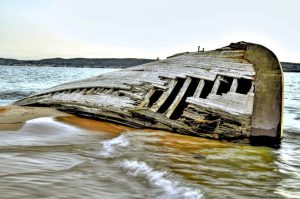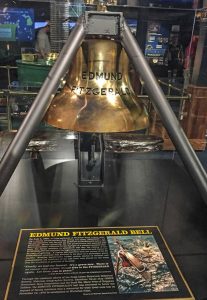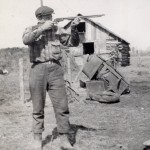Edmund Fitzgerald
 When a lake, or group of lakes, are almost the size of a small sea, with all the storm possibilities that go with a body of water the size of the sea, shipwrecks and other disasters on the water are bound to occur. There is a stretch of land along the Michigan coast, known to many as the Shipwreck Coast or the Graveyard of the Great Lakes. It is an 80 mile stretch between Grand Island and Whitefish Point, and the vicious waters have sunk hundreds of ships. Edmund Fitzgerald, Cyprus, and Vienna are just a few of the vessels lost beneath the waves, where they took their crew to a watery grave…their names forever etched in maritime lore. Their wreckages lie in varying depths of Lake Superior, the largest of the Great Lakes.
When a lake, or group of lakes, are almost the size of a small sea, with all the storm possibilities that go with a body of water the size of the sea, shipwrecks and other disasters on the water are bound to occur. There is a stretch of land along the Michigan coast, known to many as the Shipwreck Coast or the Graveyard of the Great Lakes. It is an 80 mile stretch between Grand Island and Whitefish Point, and the vicious waters have sunk hundreds of ships. Edmund Fitzgerald, Cyprus, and Vienna are just a few of the vessels lost beneath the waves, where they took their crew to a watery grave…their names forever etched in maritime lore. Their wreckages lie in varying depths of Lake Superior, the largest of the Great Lakes.
 My husband, Bob and I came up for a visit in 1975, and my Uncle Bill Spencer, the original family historian, told us about the shipwrecks of Lake Superior, and how there were many that could be seen pretty clearly when flying over the lake. I wished we could have taken such a flight, and seen those ships for myself. My thoughts drifted to the time of the wrecks, and how the accident happened and about the people who lost their lives there.
My husband, Bob and I came up for a visit in 1975, and my Uncle Bill Spencer, the original family historian, told us about the shipwrecks of Lake Superior, and how there were many that could be seen pretty clearly when flying over the lake. I wished we could have taken such a flight, and seen those ships for myself. My thoughts drifted to the time of the wrecks, and how the accident happened and about the people who lost their lives there.
Lake Superior was known for its big storms, and when the November gales came it was treacherous, especially along the Shipwreck Coast. “This part of Lake Superior is particularly treacherous thanks to a unique combination of geography and storm patterns,” Bruce Lynn, executive director of the Great Lakes Shipwreck Museum in Paradise, Michigan says. “Storms build up over Canada and the Great Plains. Their strong winds blow uninterrupted over 200 miles of open waters, building up enormous waves that drive ships into the coast or break them in half.” Fog, snow squalls, smoke from forest fires, traffic jams on the busy waters and human error add to sailing hazards.
 One massive ore carrier, the Edmund Fitzgerald was the largest to sail Lake Superior, nevertheless, it was a gale or a rogue wave that caused its sinking, but what it was is debated to this day. Gordon Lightfoot immortalized the tragedy in his song “The Wreck of the Edmund Fitzgerald.” The Fitzgerald’s 200 pound bronze bell was salvaged from the bottom of the lake later on, and and restored. The men were never recovered, because as most people know, Lake Superior never gives up her dead. The ship darted out on November 7, 1975, hoping to make Whitefish Point, but that was not to be. I think that just the questions behind the shipwrecks on Lake Superior makes the thousands of shipwrecks a huge mystery.
One massive ore carrier, the Edmund Fitzgerald was the largest to sail Lake Superior, nevertheless, it was a gale or a rogue wave that caused its sinking, but what it was is debated to this day. Gordon Lightfoot immortalized the tragedy in his song “The Wreck of the Edmund Fitzgerald.” The Fitzgerald’s 200 pound bronze bell was salvaged from the bottom of the lake later on, and and restored. The men were never recovered, because as most people know, Lake Superior never gives up her dead. The ship darted out on November 7, 1975, hoping to make Whitefish Point, but that was not to be. I think that just the questions behind the shipwrecks on Lake Superior makes the thousands of shipwrecks a huge mystery.
 For as long as I can remember, my Uncle Bill has been interested in guns. I’m certain that interest dates back to his childhood days. Being the oldest brother, and with his dad working on the railroad and away a lot, Uncle Bill helped provide for the family by hunting and fishing. Of course, many men, and women have an interest in guns, but few turn it into a career.
For as long as I can remember, my Uncle Bill has been interested in guns. I’m certain that interest dates back to his childhood days. Being the oldest brother, and with his dad working on the railroad and away a lot, Uncle Bill helped provide for the family by hunting and fishing. Of course, many men, and women have an interest in guns, but few turn it into a career.
For many years, Uncle Bill traveled to gun show after gun show, sharing his interest with many people. I remember him telling me about one particular trip that found him driving around Lake Superior on November 10, 1975. For those who don’t recall, that fateful day was the day the SS Edmund Fitzgerald was sunk in Lake Superior during an early winter storm that produced near hurricane force winds. No one knows for sure exactly how the actual sinking occurred, but my uncle told me that it was a storm to remember, and one he very much wished he had not been out in. I suppose I can understand how he felt. A storm that was bad enough to sink a 729′ ship, must have been horrible to drive in.
Since my uncle had lived most of his life around Lake Superior, he knew what an early winter storm could mean. Lake Superior had taken down many a ship and she was ruthless when she got a ship in her clutches. He said he wondered about the ships that might be on the lake in such a storm, and he was not surprised to hear of the loss of the SS Edmund Fitzgerald, when the storm was over. Oddly, the SS Edmund Fitzgerald was the only ship lost during one of the worst storms to ever hit Lake Superior, but that sinking was a permanent reminder of the perils of a life at sea.
 Being a collector, Uncle Bill collected all the newspaper articles that came out about the tragedy. A year later Gordon Lightfoot came out with a song called “The Wreck of the Edmund Fitzgerald” and when I mentioned the song to Uncle Bill, he told me of his harrowing drive around the lake on that fateful day. Then he sent me all of the articles and such that he had saved. When I was done looking it all over, I told him I was ready to send it back, but he said to keep it. That’s how he was and still is. He wants to get history into the hands of those who are interested. Maybe we are alike, he and I, because I enjoy getting little bits of history into the hands of those who are interested too.
Being a collector, Uncle Bill collected all the newspaper articles that came out about the tragedy. A year later Gordon Lightfoot came out with a song called “The Wreck of the Edmund Fitzgerald” and when I mentioned the song to Uncle Bill, he told me of his harrowing drive around the lake on that fateful day. Then he sent me all of the articles and such that he had saved. When I was done looking it all over, I told him I was ready to send it back, but he said to keep it. That’s how he was and still is. He wants to get history into the hands of those who are interested. Maybe we are alike, he and I, because I enjoy getting little bits of history into the hands of those who are interested too.

